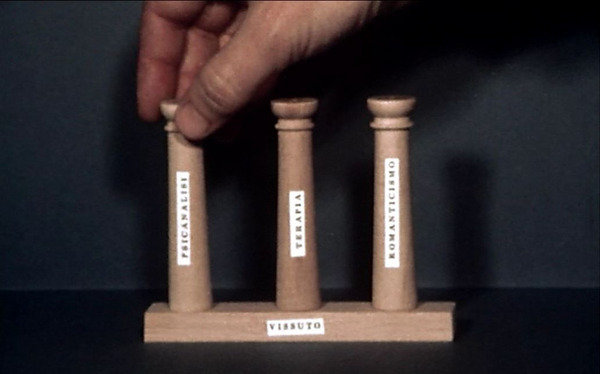Renato Ranaldi
dal 28/11/2014 al 28/11/2014
Segnalato da
28/11/2014
Renato Ranaldi
Villa Romana, Firenze
L'artista presenta tre lavori: Teoria, Mancamenti e Timparminico, che testimoniano un approccio sviluppato durante oltre cinquant'anni di ricerca artistica.

The three works to be presented at Villa Romana – where in 1984 Renato Ranaldi exhibited a series of drawings collected in the volume Angherie – are cellular nuclei of an artistic attitude that unfolded in a rich array of concepts and styles adopted over a span of fifty years and more.
Teoria (Theory), 1976
Theory consists of three cypress-wood boxes containing sixty-three Doric columns and forty-two wooden stylobates and architraves. It can be considered as a game whose spontaneous, random outcomes reveals numerous possible systems created with its one hundred and five small pieces, representing the basic elements of architecture, the vertical and the horizontal. Each element is distinguished by a word-concept taken from the lexicon, but any word whatsoever, even a proper name, could be used. The game is based on the principle of combining. A base is chosen and three or more columns are placed on it, topped by an architrave, to form a theoretical framework. Any element can be replaced by any other element. The eidetic framework produced according to the terms decided by great Chance claims the right to exist; and the interpreter of that hypothesis must waver on the borderline between a word and its meaning. One word placed beside another is in search of a link for the significance it deserves. Hence the construction of meaning includes the failure of the meaning itself, since any theoretical framework can signify either everything or its opposite.
Mancamenti (Fails), 1978
A door opens, one person after another enters the room (the artist’s studio, situated at the time in Piazza dei Ciompi), having taken two steps, collapses on the floor against the background of a white wall. The camera is immobile, eleven minutes of super 8 film, a parade of falls accompanied by the music of a bagpipe. As in a slapstick movie, the audience knows beforehand what the next person to enter the room will do. Each participant is asked to fake misfortune and does so more or less realistically, but "the floor is hard", as the film’s last caption indicates. How can you die without hurting yourself? This is the pretence of the drama and its comical reversal. The film narrates the reiterated failure to appear convincing, as radically farcical as it is dramatic in expressing the authenticity of make-believe. Everything fades away as the performers, one after another, disappear, projecting a faint signal generated by the obligation to represent.
Timparmonico (Tympharmonic), 1971
The Tympharmonic is an idiophone, consisting of a sonorous metal body made of two truncated pyramids in steel sheet, welded together at the base. The artist has admitted that, while constructing the instrument, he did not know exactly what kind of sound it would produce, since unlike traditional musical instruments that emit sound through a flared element, it had two narrow slits opening at either end. When the surface is struck at two precise points, the vibration resonating inside produces a sound that implodes, generating the harmonics. Through physical contact of all kinds, the Tympharmonic offers a vast range of sounds. When struck at the points where the harmonics develop it produces resonances that simultaneously irradiate and condense, triggering soaring spatial effects.
Renato Ranaldi was born in 1941 in Florence, where he lives and works. He has participated in various exhibitions in Italy and abroad and has published numerous texts and catalogues, including the book Calamaio Mistico (2014), which traces the intimate reasons behind his drawings. In the Sixties his work explores various expressions and linguistic modes. Since then, the semantical use of materials and techniques has always originated from the idea of subverting systems by reversing their significance. Ranaldi uses visual language and sound to trace boundary lines between the probable and the improbable, and the signs tend to declare what to include or exclude from among current directions.
Inaugurazione 29 novembre alle 188
Villa Romana
via Senese, 68 - Firenze Toscana Italia
Orario: 18
Ingresso libero



